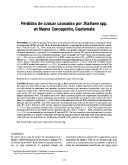Pérdidas de azúcar causadas por Diatraea spp. en Nueva Concepción, Guatemala
Alternative title
Sugar losses caused by Diatraea spp. in Escuintla, Guatemala
Description
18 ref.
Abstract
Se evaluó la pérdida de sacarosa provocada por Diatraea spp., medida por el rendimiento teórico recuperable (RTR) por cada 1 por ciento de entrenudos dañados y el porcentaje de cañas perforadas en las variedades L-7645, CP-731547 y L - 6840. Para cada variedad, se realizó un análisis de correlación y regresión entre la intensidad de infestación (II), la infestación (I) y el RTR. Los modelos utilizados fueron: lineal, cuadrático, raíz cuadrada, exponencial y potencial. Los resultados indican que la variable (II) correlacionó negativamente con el rendimiento para las tres variedades estudiadas. En la variedades CP-731547 hubo una correlación negativa (r = -0,56), pero no significativa, entre la I y el RTR, siendo que entre la II y el RTR la correlación fue significativa (r = - 0,65). El modelo que mejor explicó este comportamiento para la II fue el de raíz cuadrada (R2 = 0,42). Para la variedad L-7645 se presentó una correlación negativa (r = - 0,74), entre la II y el RTR y entre la I y el RTR también fue negativa (r = - 0,70). El modelo que mejor explicó el comportamiento para la II fue el tipo cuadrático (R2 = 0,60). En la variedad L-6840 se presentó también una correlación negativa entre RTR y la II (r = - 0,74), siendo que el modelo cuadrático fue el que mejor explicó el comportamiento (R2= 0,71). Se concluye que hay correlación negativa entre el daño ocasionado por los taladradores y el rendimiento de azúcar, el cual puede ser cuantificado por modelos matemáticos del tipo cuadrático, lineal y raíz cuadrada. The loss of sacarose, produced by the sugar cane borer Diatrea spp., was tested in three cane varieties. Indirect measures of loss were evaluated for each sample in infestation and intensity, measured through the theoretical recuperable yield (kg. of sugar/ton of sugar cane). Correlation and regression analyses were carried out between intensity and yield for each variety. The best regression model was selected based on the highest determination coeficient and the highest significance level. The models used were: lineal, cuadratic, square root, exponential and potential. In the three researched varieties, infestation and intensity were positively correlated. In the variety CP-731547 there was a negative correlation (r = -0.56) between the infestation and the RTR, and between the infestation intensity (II) and the RTR (-0.65). The model that best explained this behavior for the II was the square-root one (R2 = 0.42). For the L-7645 variety, a negative correlation between the II and the RTR was detemined (r = -0.74) the correlation between the I and the RTR was also negative (r = -0.70). The model that best explained the behavior for the II was the cuadratic one (R2 = 0.60 ). In the L - 6840, a negative corelation (r = - 0.74) was determined too between the II and the RTR. The best model was the cuadratic one. It was concluded that there is a negative correlation between the damage caused by the sugar cane borer and the sugar yield, which can be determined by mathematical models of the cuadratic square root and lineal types.
Keywords
Publisher
Centro Agronómico Tropical de Investigación y Enseñanza (CATIE), Turrialba (Costa Rica)
URI (Permanet link to cite or share this item)
https://repositorio.catie.ac.cr/handle/11554/6658Collections
- Publicaciones y documentos [4431]


